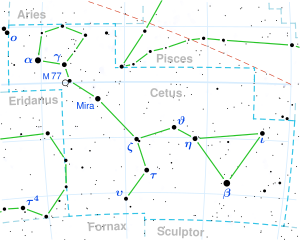| Observation data Epoch J2000 Equinox J2000 | |
|---|---|
| Constellation | Cetus |
| Right ascension | 00h 15m 28.11090s [1] |
| Declination | −16° 08′ 01.6303″ [1] |
| Apparent magnitude (V) | 11.483 [2] |
| Characteristics | |
| Spectral type | M3.5V [3] |
| Astrometry | |
| Radial velocity (Rv) | -26.43 ± 0.1 [4] km/s |
| Proper motion (μ) | RA: 731.83 [1] mas/yr Dec.: -607.73 [1] mas/yr |
| Parallax (π) | 166.6±0.3 mas [3] |
| Distance | 19.58 ± 0.04 ly (6.00 ± 0.01 pc) |
| Absolute magnitude (MV) | 12.70 ± 0.01 / 15.12 ± 0.09 [3] |
| Orbit [3] | |
| Period (P) | 4.55726+0.00075 −0.00074 y. [5] |
| Semi-major axis (a) | 0.3037 ± 0.0005″ |
| Eccentricity (e) | 0.36136+0.00097 −0.00098 [5] |
| Inclination (i) | 143.93+0.25 −0.24 [5] ° |
| Longitude of the node (Ω) | 62.8 ± 0.4° |
| Periastron epoch (T) | JD 2449850.4 ± 0.8 |
| Argument of periastron (ω) (secondary) | 166.6 ± 0.5° |
| Details [3] | |
| GJ 1005 A | |
| Mass | 0.179 ± 0.002 M☉ |
| Radius | 0.23 R☉ |
| Temperature | 3341±224 [6] K |
| Metallicity [Fe/H] | -0.41 [5] dex |
| GJ 1005 B | |
| Mass | 0.112 ± 0.001 M☉ |
| Other designations | |
| Gaia DR2 2368293487260807040, HIP 1242, G 158-50, G 266-76, LHS 1047, LP 764-87, LTT 114, 2MASS J00152799-1608008 | |
| Database references | |
| SIMBAD | data |
| ARICNS | A |
| B | |
Location of GJ 1005 in the constellation Cetus | |
GJ 1005 is a system of two red dwarfs, located in constellation Cetus at 19.6 light-years from Earth. [7] The primary star is a M4V class star while the secondary is a class M7V.[ citation needed ]
The system was observed with the Hubble Space Telescope in the 1990s with its Fine Guidance Sensor. [7] This data helped determine the mass of each of the components of L722-22/ LHS 1047 / GJ 1005. [7]
